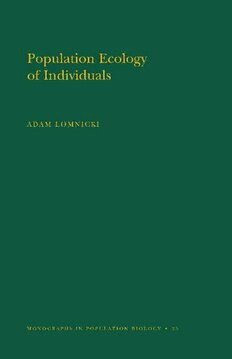
Population Ecology of Individuals. (MPB-25), Volume 25 PDF
Preview Population Ecology of Individuals. (MPB-25), Volume 25
Population Ecology of Individuals MONOGRAPHS IN POPULATION BIOLOGY EDITED BY ROBERT M. MAY 1. The Theory of Island Biogeography, by Robert H. MacArthur and Edward O. Wilson 2. Evolution in Changing Environments: Some Theoretical Explorations, by Richard Levins 3. Adaptive Geometry of Trees, by Henry S. Horn 4. Theoretical Aspects of Population Genetics, by Motoo Kimura and Tomoko Ohta 5. Populations in a Seasonal Environment, by Stephen D. Fretwell 6. Stability and Complexity in Model Ecosystems, by Robert M. May 7. Competition and the Structure of Bird Communities, by Martin L. Cody 8. Sex and Evolution, by George C. Williams 9. Group Selection in Predator-Prey Communities, by Michael E. Gilpin 10. Geographic Variation, Speciation, and Clines, by John A. Endler 11. Food Webs and Niche Space, by Joel E. Cohen 12. Caste and Ecology in the Social Insects, by George F. Oster and Edward O. Wilson 13. The Dynamics of Arthropod Predator-Prey Systems, by Michael P. Hassell 14. Some Adaptations of Marsh-Nesting Blackbirds, by Gordon H. Orians 15. Evolutionary Biology of Parasites, by Peter W. Price 16. Cultural Transmission and Evolution: A Quantitative Approach, by L. L. Cavalli-Sforza and M. W. Feldman 17. Resource Competition and Community Structure, by David Tilman 18. The Theory of Sex Allocation, by Eric L. Charnov 19. Mate Choice in Plants: Tactics, Mechanisms, and Consequences, by Mary F. Wilson and Nancy Burley 20. The Florida Scrub Jay: Demography of a Cooperative-Breeding Bird, by Glen E. Woolfenden and John W. Fitzpatrick 21. Natural Selection in the Wild, by John A. Endler 22. Theoretical Studies on Sex Ratio Evolution, by Samuel Karlin and Sabin Lessard 23. A Hierarchical Concept of Ecosystems, by R. V. O'Neill, D. L. DeAngelis, J. B. Waide, and T. F. H. Allen 24. Population Ecology of the Cooperatively Breeding Acorn Woodpecker, by Walter D. Koenig and Ronald L. Mumme 25. Population Ecology of Individuals, by Adam Lomnicki Population Ecology of Individuals ADAM LOMNICKI PRINCETON UNIVERSITY PRESS PRINCETON, NEW JERSEY 1988 Copyright © 1988 by Princeton University Press Published by Princeton University Press, 41 William Street, Princeton, New Jersey 08540 In the United Kingdom: Princeton University Press, Guildford, Surrey ALL RIGHTS RESERVED Library of Congress Cataloging in Publication Data will be found on the last printed page of this book ISBN 0-691-08471-8 (cloth) 0-691-08462-9 (pbk.) This book has been composed in Linotron Baskerville Clothbound editions of Princeton University Press books are printed on acid-free paper, and binding materials are chosen for strength and durability. Paperbacks, although satisfactory for personal collections, are not usually suitable for library rebinding Printed in the United States of America by Princeton University Press, Princeton, New Jersey Contents Preface ix 1. Introduction: Basic Models of Population Ecology and Intrapopulation Variability 1 1.1. Individuals and Superorganisms 1 1.2. Unlimited Population Growth 5 1.3. Limited Population Growth 11 1.4. Limited Growth in Discrete Places 15 2. Individual Variation in Resource Partitioning and Population Dynamics 20 2.1. Resource Partitioning among Individuals 20 2.2. Four Versions of the Model of Resource Partitioning 25 2.3. Population Stability and Persistence 30 2.4. Laboratory and Field Data 34 2.5. Scramble and Contest Competition 42 3. Individual Variation of Body Weight in Plant and Animal Populations 46 3.1. Empirical Data 46 3.2. Some Simple Explanations and Their Shortcomings 48 3.3. Weight Differentiation under Stochastic Growth 53 3.4. Deterministic Growth and the Importance of Pearly Differentiation 57 3.5. Weight Differentiation in Competition for Space 59 3.6. Weight Distribution and General Properties of the Function y{x) 61 v CONTENTS 4. Individual Differences and Hereditary Variation 65 4.1. Variation as an Adaptation 66 4.2. Differential Mortality and the Soft Selection Concept 72 4.3. Genetic Determination of Individual Success in the Ecological World 81 5. Age and Overlapping Generations 86 5.1. Age-Dependent Individual Success 86 5.2. Distinct Life Stages within a Population 91 5.3. Simple Extension of the Models of Population Dynamics to Overlapping Generations 95 5.4. Discrete Versus Continuous Models of Population Dynamics 100 6. The Mechanism of Contest Competition 106 6.1. Definition of Contest Competition 107 6.2. Population Effects of Contest Competition 111 6.3. The Case Study: Competition among Gall Aphids Pemphigus belae 116 6.4. Social Hierarchy, Territoriality, and Contest Competition 118 6.5. Evolutionarily Stable Arms Investments, or How Contest Competition Can Be Regarded as a Result of Arms Races 120 7. Self-regulation of Population Size 124 7.1. Self-regulation in Terms of Game Theory 126 7.2. Self-regulation in Confined Laboratory Populations 132 7.3. Optimal Reproduction in Populations with Unequal Resource Partitioning 136 8. Emigration and Unequal Resource Partitioning 143 8.1. Emigration from Groups of Related and Unrelated Individuals 143 CONTENTS 8.2. Impermanent Local Habitats in Heterogeneous Space 150 8.3. Evolution of Emigration from Local Populations without Unequal Resource Partitioning 155 8.4. Emigration from Local Populations with Unequal Resource Partitioning 161 8.5. Emigration, and Scramble and Contest Competition 166 8.6. Free and Despotic Distribution of Animals 170 9. Field and Laboratory Populations of Animals 174 9.1. Limitations of Field Studies 174 9.2. Animal Populations in the Laboratory 176 9.3. Free and Confined Laboratory Populations of Hydra 178 9.4. Free and Confined Laboratory Populations of Flour Beetles 183 9.5. Confined Populations of Animals in the Field 186 10. Spatial and Temporal Heterogeneity and Stability of Ecological Systems 189 10.1. Reproduction in Spatially and Temporally Heterogeneous Environments 190 10.2. Spatial Microheterogeneity 194 10.3. Direct Relations between Spatial Heterogeneity, Individual Variability, and Stability 197 10.4. Spatial Heterogeneity and Species Diversity 199 10.5. Spatial Heterogeneity and Ecosystem Stability 201 References 205 Author Index 217 Subject Index 220
